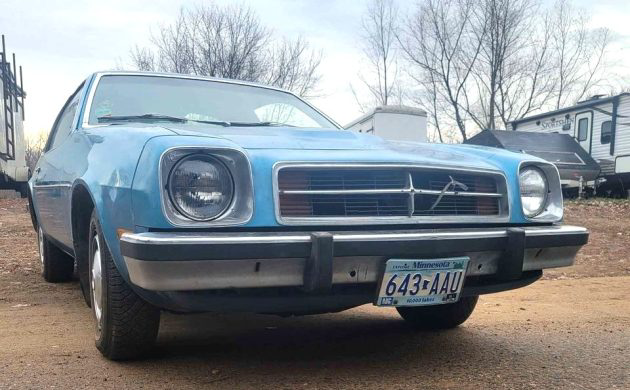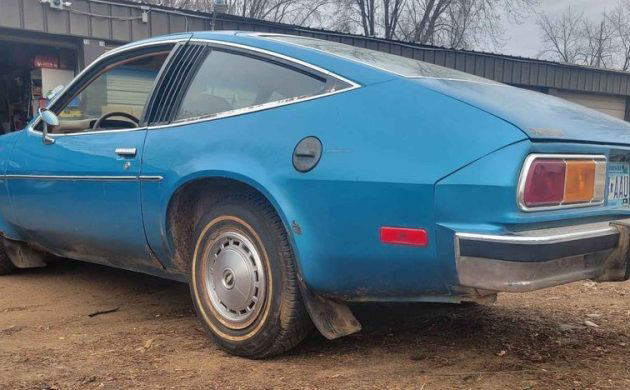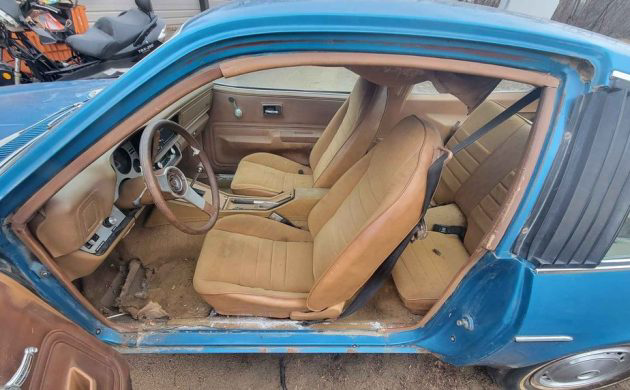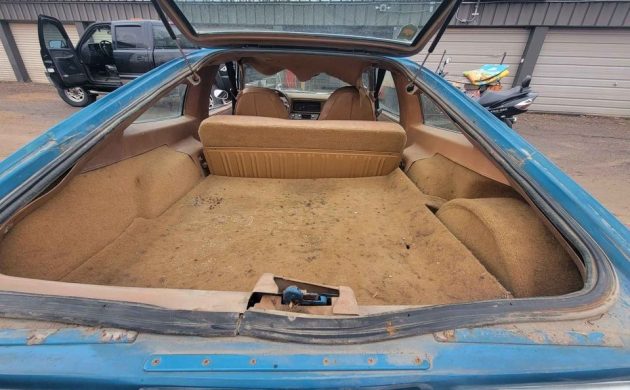
Perhaps to redeem themselves from the troubles of the early 1970s Vega, Chevrolet rolled out the Monza in 1975. It was a sportier product based on the same platform and available in both coupe and hatchback formats. Badge-engineered versions of the car would soon pop up throughout General Motors as economy cars were in vogue at the time. This 1979 Monza 2+2 was last registered in 1990 and looks rather good overall for 34 years of hibernation. Located in Chaska, Minnesota, this subcompact is available here on Facebook Marketplace for $3,500. Another tip brought to us by “Lothar … of the Hill People.”

Chevrolet resurrected the Monza nameplate (remember the Corvair subseries under that moniker?) in the mid-1970s and it remained in production until 1980. It used routine engineering of the day, including rear-wheel-drive. While most Monza’s were sold with an inline-4, a V6, and a small-block V8 became optional as the years wore on. I owned a similar 1980 Pontiac Sunbird, and it was a fun little car, although hardly stimulating in the performance department. The target market was likely folks who were also considering the Ford Mustang II and some of the Japanese imports.

Though you could order the Town Coupe with its more formal roof, Chevy sold a lot of hatchbacks like this one. By 1979, they were powered by the 151 cubic inch inline-4 that was known as the “Iron Duke” which was the engine that was also in my Sunbird. It used a 2-barrel carburetor, and the output was rated at 90 hp SAE net. This one has an automatic transmission, and the combination would not exactly make it a speed rocket.

The seller says this is a one-owner car with only 18,000 miles. We’re told it runs and drives, but what work was needed to get there since the license plate has a sticker from the ‘90s as its last registration? The body may be okay, but the blue paint is pretty faded. Some wax and elbow grease might help that, and the interior looks okay, though we wonder about the carpeting. But what unknowns might still be lurking after having taken a three-decade nap?







Yup, yesssir only 18,000 miles. The seller also mentions it’s a “kool old car” without offering an engine pic.
Looks more like 118,000 miles.
218,000! 🤣🤣🤣
318,000…
Monza was in development in 1971, as an upscale offering to the Vega – well before Vega’s problems were widely known to the market.
The 1974 Vega was initially set to be the first H-body to receive GM’s RC2-206 rotary engine, but that was changed to the Monza – there are photos floating around of pilot builds with rotary badging on them. The engine ended up being canceled, of course. Since the H-body platform was developed to support a V8 (early production Vegas had transmission crossmembers with dual exhaust reliefs), it was simple to offer V6s and V8s in the Monza (unless you needed to change the sparkies in the V8!).
I’ve never heard that the Vega was to have had the Wankel. Why spend all that money developing a (really awful) aluminum four only to replace it with a Wankel with inevitable seal failures two years later (before everyone found out what a turd the 2300 was)?
My understand has always been that the initial goal of the Monza was to be a showcase for GM’s new Wankel, and a sports coupe competitor for the Mustang II, Celica, Capri, and 240Z.
My recall may be wrong here, but I remember the Vega was originally suppose to get the rotary in the ’74 model year as part of a “performance” package… but because of development delays, it’s debut was moved to the Monza for the ’75 model year… which we all know never happened. The 2.3 aluminum 4 was always going remain in the line up for lesser spec cars.
I currently have a vintage Mazda rotary in my fleet and I think a rotary Vega (or Monza) would have been interesting… but given GMs quality issues of the time it would have probably been a disaster.
Should have renamed this ‘Vega 2.0″
Long live the death of GM H bodies
Monza Spyder? … maybe … this one? No thanks.
I bought a new 1976 Olds Starfire GT in competition orange. My brother in law immediately christened it the “BelchFire GT” in honor of a comic strip of the day. 4-speed, styled steel wheels, Firestone 500 radials (whose steel belts wrapped themselves up like a Mobius strip) and the odd-fire 3.8 V-6 – one of the unhappiest engines of all time.
It was a good-looking car but it could not run smoothly and the tires were the subject of a mass action lawsuit. The seats were very comfortable and it handled fairly predictably. The pilot bearing went out, the doors rusted and I really wish I’d traded it in on a ’79 Trans Am before I got married.
Friend of mine called his the Scrapfire GT.
Lol…
I thought the 2+2’s had the quad rectangular headlights in the front while the coupes had the 7″ round headlights. I know 1976 or 77 had the quad light setup – a friend has one that I have been bugging him about for 35 years because of the race-built 350 under the hood. It ran 12.60 in its day and would lay rubber shifting from 3rd to 4th. It is a true barn find, whenever he sells it to me – its been in his shop for three decades.
I thought they did to. Had a 1980 2+2 hatchback with the 231 Buick V-6 automatic. Fast coupe with the rally hubcaps. Good economy car. Never was a problem. Good Monza
When the Monza/Starfire/Skyhawk came out, all had square dual headlamps. When the Towne Coupe came out, single round headlights were used on this quick attempt at a cheaper version, and this treatment was used on low-line Monzas, including the stationwagon, that was little more than a Vega KammBack with a different front fascia and a motor swap.
A friend of mine had a Monza when I was in high school. With its light weight and rear wheel drive, it absolutely sucked in the snow. We did a lot of “drifting” with it before it was considered cool.😂👍
I have to say that the Vega and the Monza were really great looking cars. It’s too bad that the execution was juuuuuust a little bit off.
I think either one would be fun to own. But the Monza needs a super small but powerful 8. That would be a great little car…
They shoe-horned in a 262 small block into an engine bay designed for a much smaller Wankel.
That Wankel got so close to production that I can remember seeing spark plugs for it listed in an auto parts store, ages ago.
These sent buyers running to the Toyota and Datsun dealerships…
A car that you hardly see on the road anymore. The final year was 1980. The Buick Skyhawk and Oldsmobile Starfire was discontinued on December 14th, 1979. The Chevy Monza and Pontiac Sunbird soldiered on until the final cars left the assembly plant in the summer of 1980.
As Stembridge stated, the Monza was a separate model designed to compete with the Celica, 240Z, Mustang II, and “post-pony car,” sports coupés coming to market in the early seventies. It was based on the Vega, but not initially designed to replace it, any more than the Camaro was designed to replace the Nova.
The Monza was to have been a showcase for GM’s Wankel, before the new realities of the fuel crisis and emission controls set in. While Wankels are small, smooth, and cheap to make, their fuel economy is horrendous, and controlling emissions is problematic. GM fours, sixes, and a 262 small block were squeezed in, a hood bulge created, and a whole line of small sporty cars was created. The 262 barely fit, and required lifting from the engine mounts to service the two rear spark plugs.
At the same time, the Vega 2300 engine was blowing head gaskets and oil fumes all over the country. Cheaper versions of the Monza, first the Chevy Monza Towne Coupe,” were created to fill the void in GM’s small car portfolio created by the Vega debacle.
The two 7″ round headlight front was quickly pressed into service for low-line Monzas. The Vega Kammback got the same treatment, and became the Monza Stationwagon. Pontiac now got its “Sunbird,” notably, the only member of the family without the 4-light sagging rubber front cap that (dis-) graced the fronts of the higher line Monzas, Starfires, and Skyhawks.
The car pictured is a later model low-line Monza. They were attractive cars in the showroom, but the seventies GM build quality was abysmal. The survival rate be really, really low.
i had a yellow 76 ran great 4 cylinder 140 engine bought it for 3 bucks just put tires on it and a water pump had it for a couple of years
I had a 1979 buick Skyhawk with the V8 4 speed as a rental car while my 1982 Toyota short bed 4×4 was had its 5 speed transmission was worked on & it was decent little car I knew little about but was faster then my friends 1978 cutlass Supreme with water fall grill lol the good old days where horsepower in both cars fell short of a dodge 340 demon but it’s what we had gas seemed high when your teenager !
I bought a new 79 Monza. Carmine red coupe with vinyl tan interior, A/C, PS, PB, V6 Guage package, sport suspension.
It was peppy and handled well. As far as Chevy build quality in ’79, a Yugo would have put it to shame.